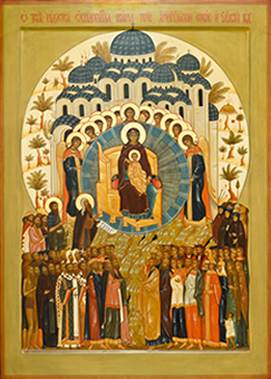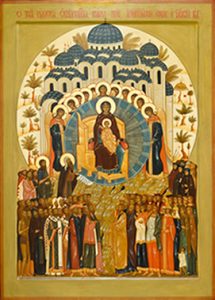“In Thee rejoices, Maiden, who are full of grace, all creation, the ranks of angelic hosts, and the lineage of mankind. A temple sanctified and a paradise of the mind, you are the boast of the chaste, from whom our God was incarnate and became a new-born child, yet he is God before time, unto every age. For he has made your pure womb to be his throne; wider he has made you than the heavens; without end he has fashioned you. In Thee rejoices, Maiden, who are full of grace, all of creation. Glory to you!”
(The magalynarion of the St Basil Liturgy)
The central image and subject of the icon is the Mother of God enthroned within an aureole with the Christ child sitting majestically on her knees. She and the Child Jesus are displayed frontally amidst the heavenly and earthly hierarchies. It was the intention of the icon painter to create a bond between these two separate, yet infinitely connected forms of existence. Surrounding her and the child are a choir of angels; celestial servants in the Mother of God’s service. Beneath are a host of saints, prophets, apostles, martyrs, clergy and believers forming a procession, rejoicing and singing her praises. All of God’s creatures in heaven and on earth give glory and honor to the Mother of God, a visual manifestation to the poetic hymn’s verses.
The Mother Mary is displayed in a blue tunic (chiton) and a purple mantle (maphorion), which respectively signify her human nature and the divine grace bestowed upon her. Amongst all women she was chosen by God to bear the Christ Child, Jesus. The Virgin Mary is herself a dwelling place, a Holy Temple or Throne, the source of the embodiment of the word made flesh, the Incarnation.
The three stars on Mary’s veil or maphorion, above her head and by her shoulders, symbolize both the threefold nature of her eternal virginity; before, during and after the birth of Jesus as well as signifying the Holy Trinity. In the Russian Orthodox Church, Mary is venerated as ‘The Holy Virgin Mary’ and ‘The Holy Mother of God’; this latter title of honor expresses her unique relationship with the Second Person of the Holy Trinity, God the Son.
The Greek inscription ‘MR THOU’ or ‘Meter Theou’ appears on every Marian icon and stands for Mother of God or more accurately ‘Birth-giver of God” (Theotokos). This form of address was approved by the Council of Ephesus in 431. At this time, Nestorius (c. 386-451), the Patriarch of Constantinople, argued that Mary was the Mother of Jesus – a reference to his humanity – but not the Mother of God. The council rejected his interpretation and upheld the title. On the icon ‘In Thee rejoices’, the Greek inscription appears to the right and left of Mary’s head.
It is believed the angel directly above the Mother of God is the Archangel Michael; he stands together in the circle with the Archangels Gabriel, Michael, Raphael, Uriel, Raguel, Remiel and Saraqael. A host of other angels surround the central figure, some merely evident from their halos. The Virgin Mary and Christ Child are centrally positioned within a mandorla composed of three concentric circles in shades of blue; a heavenly cerulean blue, a deep ultra-marine and a darker azure. From the triple aureole, the image of Mary, Mother of God emerges, radiant in her divine nature. Rays of light burst out from the central figure highlighting and embracing the totality of creation.
Within the outer circle which surrounds the two enthroned figures, a domed cathedral stands amid a garden of palms, fruit-laden trees and foliage. The white color emerges as a reflection of the thin, outer rim of the mandorla, enfolding the celestial ensemble in a harmonious unity. The five-doomed Temple symbolizes New or Heavenly Jerusalem; the painter chose the Hagia Sofia, the original Greek name of which means “Shrine of the Holy Wisdom of God” in the then-named Constantinople as a model for the image.
The upper segment of the icon represents Heavenly Jerusalem and a tree-filled Garden of Paradise; the Kingdom of Christ in Heaven where God the Father, Christ the King, the Saints and Angels reside in all their glory. The lower portion of the icon also refers, in its own way, to Heavenly Jerusalem. The Church of Christ on Earth, members of God’s kingdom on earth at the foot of the heavenly summit singing praise in honor of the Virgin Mary, whose “…pure womb to be his throne; wider he has made you than the heavens; without end…”.
On the left-hand side of the enthroned figures stands the haloed John of Damascus (ca. 651/ 676-750), writer of theological treatises and anthems to among others, the Mother of God. On the scroll that he holds is the opening verse of the eponymous hymn which is attributed to him;“In Thee rejoices, Maiden, who are full of grace, all creation, the ranks of angelic hosts, and the lineage of mankind.” This iconographic style is referred to as an illustrative-icon. Both in the heavenly and earthly hierarchies, the Mother of God is lauded and praised as the All-Holy and All-Merciful Temple of Wisdom.
A few steps behind him, also with a halo, is John the Forerunner – also more familiarly known as John the Baptist – who guides all people to heaven. He is followed by the Apostles, the Kings David and Solomon: in the procession below can be seen John Chrysostom, Archbishop of Constantinople; Basil the Great; Nicholas of Myra; monks, hermits and prophets.
On the bottom to the right, leading the procession are the Apostles Peter and Paul. Among the group can be seen numerous saints: Helena, Olga of Pskov also known as Olga of Kiev; the martyr princes Boris and Gleb; Vladimir; holy virgins and other saints and martyrs. The entire host of saints rejoice in Theotokos, venerating the Holy Virgin Mary, who gave birth to the divine Christ Child, Jesus.
From the standard, stylized elongated figures and faces, it can be determined that the icon was painted in the manner of the atelier of Dionysius. A 16th Century icon from this workshop served as the model and inspiration for this icon. The original icon was created for the Cathedral of the Assumption located in the town of Dimitrov’s Kremlin and is presently to be seen in the Tretyakow Gallery in Moscow. This illustrative-icon inspired by the eponymous hymn, faithfully follows the traditions of Moscow iconography.
Despite the fact that there is no direct reference to a specific cathedral as the model for the icon, the Hagia Sofia was not an entirely fortuitous choice. In Eastern Orthodoxy, for more than a thousand years, it was the Cathedral of the Ecumenical Patriarchate of Constantinople. In its role as Mother Church of Orthodox Christianity, it has special significance for this exhibition where the Greek Mt Athos, also referred to as the Garden of the Mother of God, figures predominantly.
After the Fall of Constantinople to the Muslim Ottoman Empire in 1543, the center of Eastern Orthodoxy shifted to Moscow, replacing the Byzantine capital as heir; ‘the third Rome’, the new earthly Jerusalem. Within the context of this new status, icons dedicated to the Mother of God, including the original ‘In Thee rejoices’, sprang to life in Russia. Also, according to the Orthodox calendar, the end of the world was predicted in this period of time. The faithful eagerly awaited entrance to the Heavenly Jerusalem, embraced by Mary, Mother of God, ‘Cause of Our Joy.’
By Inge Wierda
The 2013 exhibition at the Icon Museum in the Dutch town of Kampen; “Moscow School: Past and Present” was an occasion to present among other present-day Russian icons, ‘In Thee Rejoices’. This article also appeared in the catalogue from the exhibition, Moskouse School: Traditie en Heden. Hedendaagse Russische ikonen en muurschilderijen (Utrecht: Kok, 2013), pp. 22-25.

